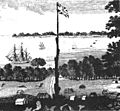Back-to-Africa movement facts for kids
The Back-to-Africa movement was a big idea for African Americans and other black people living outside of Africa. It was about helping them move back to Africa, which many saw as their true homeland. This idea of returning to Africa, often called "repatriation," started way back in the 1700s. It was especially for people who had been enslaved and then freed, or for free black people living in places like North America and Europe.
Contents
Why Did People Want to Go Back?
After slavery ended in many parts of the world, black people in America and other Western countries still faced many challenges. They often experienced unfair treatment, known as racism and discrimination. They were denied equal rights and opportunities. Because of this, many felt that they would never truly be free or equal where they were.
The idea of going back to Africa offered hope. It was a chance to:
- Build a new life in a place where they could be truly free.
- Create their own communities and governments.
- Escape the harsh realities of racism and inequality.
- Reconnect with their heritage and culture.
Early Efforts to Return
The first organized efforts to help black people move back to Africa began in the late 1700s. One of the earliest places they went was Sierra Leone, a country on the west coast of Africa. This area was set up as a home for freed slaves from Britain and North America.
The American Colonization Society
In the early 1800s, a group called the American Colonization Society (ACS) was formed in the United States. Their main goal was to help free black people move to Africa. They believed this would solve some of the racial problems in America. In 1822, the ACS helped establish a new colony in West Africa, which later became the country of Liberia. Many African Americans moved there, hoping for a better life.
Challenges in Liberia
Life in Liberia was not always easy for the new settlers. They faced many difficulties, including:
- New diseases they weren't used to.
- Challenges in farming and building new homes.
- Sometimes, conflicts with the local African people already living there.
Despite these problems, Liberia became an independent country in 1847, founded by these returning African Americans.
Later Movements and Ideas
The Back-to-Africa idea continued to be important even after the American Civil War and the end of slavery in the U.S. In the early 1900s, a powerful leader named Marcus Garvey became very famous for promoting this movement.
Marcus Garvey's Vision
Marcus Garvey was a Jamaican political leader who believed strongly in black pride and self-reliance. He founded the Universal Negro Improvement Association and African Communities League (UNIA) in 1914. Garvey encouraged African Americans and black people worldwide to unite and return to Africa. He wanted to build a strong, independent black nation there.
Garvey's movement was very popular and inspired millions of people. He even started a shipping company called the Black Star Line to help transport people and goods to Africa. However, his plans faced many obstacles and eventually did not fully succeed in moving large numbers of people.
The Legacy of the Movement
While millions of people didn't end up moving back to Africa, the Back-to-Africa movement had a lasting impact. It helped to:
- Inspire a sense of pride and unity among black people.
- Encourage the idea of self-determination and building strong black communities.
- Influence later civil rights movements and pan-African ideas, which focus on the unity of all African people.
Today, the movement is remembered as an important part of African-American history and the ongoing search for freedom and equality.
Images for kids



